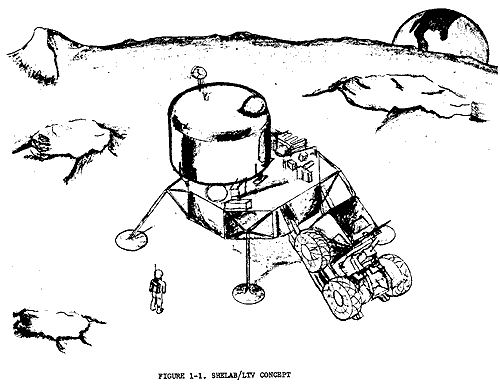Continuing my inquiry into the legend of Eduardo San Juan and the lunar rover, you’ll remember that I sent an email to historians at NASA and Boeing to ask about him. Mike Wright of the Marshall Space Flight Center History Office emailed back with a very interesting PDF attached: a report and conceptual design for the possible construction of a lunar shelter and roving vehicle, submitted to NASA MSFC in November 1964 by “E.C. San Juan” of Hayes International Corporation. The document is just one of a series of “Apollo Logistics Support Systems” papers submitted by Hayes engineers as part of a NASA MSFC contract to research lunar surface exploration technologies for a project called “MOLAB,” which would later be cancelled.
- Apollo logistics support systems MOLAB studies : lunar shelter/rover conceptual design and evaluation / prepared … by E.C. San Juan. Lunar shelter/rover conceptual design and evaluation (LPI CIRS Library Catalog Entry, PDF format)
- Other MOLAB Studies from Hayes engineers on NTRS
Looking over San Juan’s work, it looks like he was an engineer who knew his way around aerospace concepts and hardware, with lots of math and physics and charts — although sections of the report lapse into pithy exposition of basic concepts in descriptive astronomy and spaceflight which I thought would be common knowledge to anyone receiving this at MSFC. The lunar terrain rover (LTV) is part of a larger proposed “lunar base” package composed of a lander with a two-man shelter/laboratory module (SHELAB), a one-man lunar rover, and a spacesuit-attachable rocket belt.

The SHELAB/LTV concept might appear remarkably prescient, superficially resembling Grumman’s Lunar Module five years before Apollo 11, and Boeing/Delco’s Lunar Rover seven years before Apollo 15. This is better placed in context, however, considering that this comes about two years after MSFC accepted the Grumman LM contract, and knowing that the design influences of Von Braun, Bekker, and Pavlics had already informed a whole generation of spacecraft designers since the 1950s. Given the recollections that San Juan’s daughter has of MSFC, I can easily believe that he did indeed have access to NASA material and personnel while putting together the MOLAB study, including Wernher Von Braun himself.
Given this, we can conclude that San Juan conceptualized a lunar rover along the lines of existing work in the field, but not the rover finally contracted to Boeing and GM/Delco for Apollo 15, 16, and 17. Nikodemski gives us the word on that.
(In some ways, I wish the MOLAB project had pushed through; it looks remarkably ambitious with the equipment proposed by the Hayes study. Note how the scale of their lunar lander is much larger than the Grumman LM, and part of the plan involved a network of LMs forming a decentralized lunar base. I’m sure Von Braun would have approved.)
Next entry, I’ll explore the differences and similarities between San Juan’s proposed rover and the actual Apollo LRV.